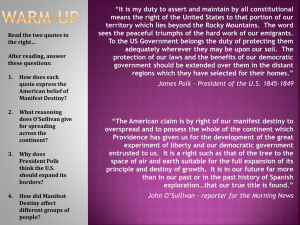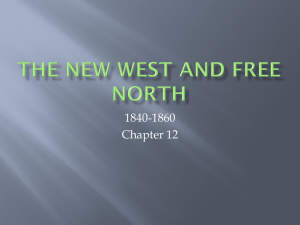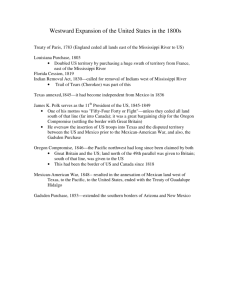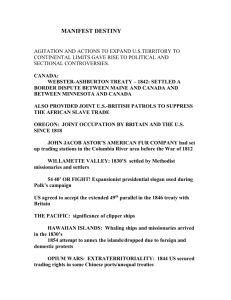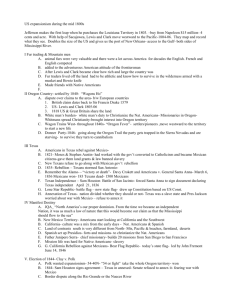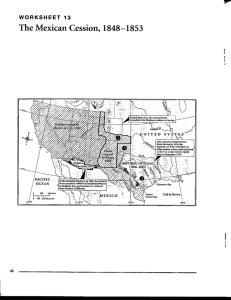Competency Goal #2 answer Sheet - Taylored teaching
advertisement
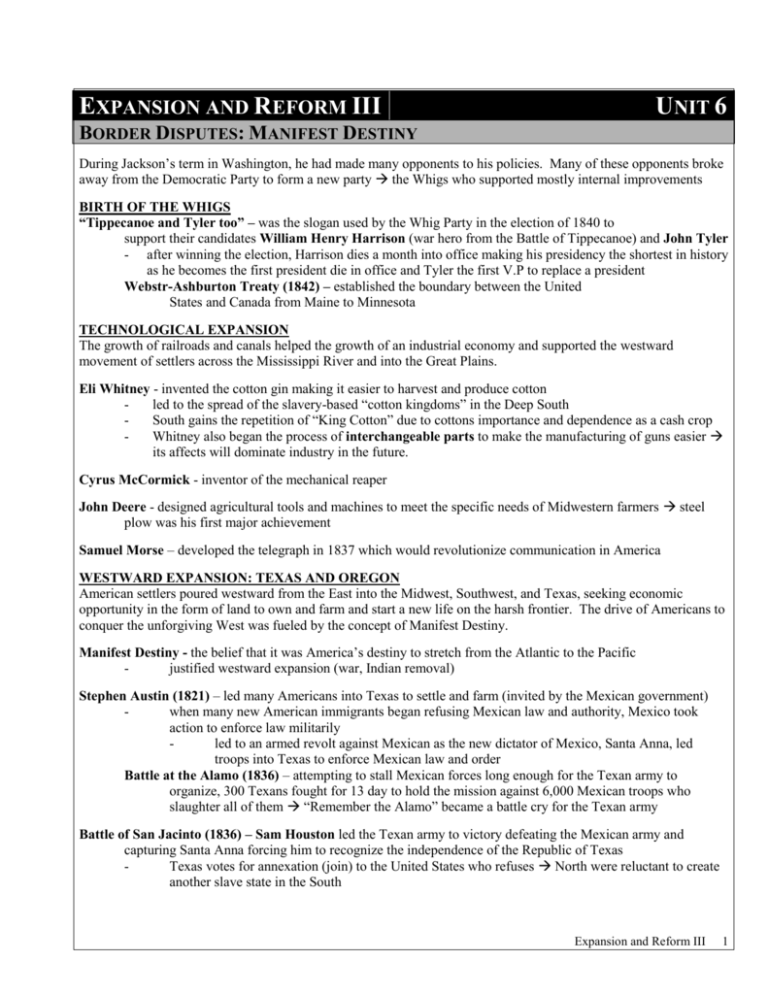
EXPANSION AND REFORM III UNIT 6 BORDER DISPUTES: MANIFEST DESTINY During Jackson’s term in Washington, he had made many opponents to his policies. Many of these opponents broke away from the Democratic Party to form a new party the Whigs who supported mostly internal improvements BIRTH OF THE WHIGS “Tippecanoe and Tyler too” – was the slogan used by the Whig Party in the election of 1840 to support their candidates William Henry Harrison (war hero from the Battle of Tippecanoe) and John Tyler - after winning the election, Harrison dies a month into office making his presidency the shortest in history as he becomes the first president die in office and Tyler the first V.P to replace a president Webstr-Ashburton Treaty (1842) – established the boundary between the United States and Canada from Maine to Minnesota TECHNOLOGICAL EXPANSION The growth of railroads and canals helped the growth of an industrial economy and supported the westward movement of settlers across the Mississippi River and into the Great Plains. Eli Whitney - invented the cotton gin making it easier to harvest and produce cotton led to the spread of the slavery-based “cotton kingdoms” in the Deep South South gains the repetition of “King Cotton” due to cottons importance and dependence as a cash crop Whitney also began the process of interchangeable parts to make the manufacturing of guns easier its affects will dominate industry in the future. Cyrus McCormick - inventor of the mechanical reaper John Deere - designed agricultural tools and machines to meet the specific needs of Midwestern farmers steel plow was his first major achievement Samuel Morse – developed the telegraph in 1837 which would revolutionize communication in America WESTWARD EXPANSION: TEXAS AND OREGON American settlers poured westward from the East into the Midwest, Southwest, and Texas, seeking economic opportunity in the form of land to own and farm and start a new life on the harsh frontier. The drive of Americans to conquer the unforgiving West was fueled by the concept of Manifest Destiny. Manifest Destiny - the belief that it was America’s destiny to stretch from the Atlantic to the Pacific justified westward expansion (war, Indian removal) Stephen Austin (1821) – led many Americans into Texas to settle and farm (invited by the Mexican government) when many new American immigrants began refusing Mexican law and authority, Mexico took action to enforce law militarily led to an armed revolt against Mexican as the new dictator of Mexico, Santa Anna, led troops into Texas to enforce Mexican law and order Battle at the Alamo (1836) – attempting to stall Mexican forces long enough for the Texan army to organize, 300 Texans fought for 13 day to hold the mission against 6,000 Mexican troops who slaughter all of them “Remember the Alamo” became a battle cry for the Texan army Battle of San Jacinto (1836) – Sam Houston led the Texan army to victory defeating the Mexican army and capturing Santa Anna forcing him to recognize the independence of the Republic of Texas Texas votes for annexation (join) to the United States who refuses North were reluctant to create another slave state in the South Expansion and Reform III 1 Election of 1844 – James K. Polk, a dark horse (little known) democrat wins the election promising three things: annex Texas annex Oregon Territory purchase California from Mexico Oregon Territory – Northwestern pacific territory split between the U.S. and Britain famous for the Oregon Trail that led settlers from Independence, Missouri through the Oregon Territory to the Pacific U.S. almost went to war with Britain over the territory when settlers demanded that a final border be established at 54’-40’ (deep into Canada) “54’-40’ or Fight” became the slogan for those wanting America to fully gain this territory James K. Polk had campaigned that he would bring the Oregon Territory into the Union which he does in 1848 MEXICAN-AMERICAN WAR (1846-1848) A border conflict between the U.S. and Mexico soon after Texas’s addition to the Union leads the two nations into war over disputed territorial claims: U.S. claim – border between the two nations the Rio Grande River Mexico claim – border was set at the Nueces River President Polk attempted to buy the disputed territory along with California from the Mexican government who refused with both sides opting for war. Polk then ordered troops to make camp along the Rio Grande River, sending the navy to the Pacific near California, and sending another army towards California angered by this aggressive move the Mexicans fire on U.S. troops “starting” the war Congress calls for 50,000 volunteers receives 73,000 (Tennessee “the volunteer state” sends the most) Gen. Zachary Taylor leads American troops south across the river pushing the Mexican forces back several times before defeating them at the Battle of Monterrey his actions in the war will make him a war hero which threatened Polk and the Democrat’s political position (Taylor was a Whig) Gen. John Fremont – leads a small American force that captures California with little resistance and then declares its independence from Mexican renaming the territory the Bear Flag Republic Gen. Winfield Scott – leads American troops from the Mexican port of Veracruz to the capital of Mexico City American forces capture the capital (first time American forces have occupied an enemy capital) Treaty of Guadalupe-Hidalgo (1848) – America’s victory led to the acquisition of an enormous territory as that included the present day Southwestern states while also settling the border dispute at the Rio Grande Mexican Cession – land gained by the U.S. as a result of the Mexican-American War includes California, Nevada, Utah, Arizona, and parts of Colorado and New Mexico Wilmot Proviso – a controversial proposal that any new lands gained from Mexico would not be open to slavery New England opposed new lands that would extend slavery - proposal doesn’t pass, but the attitude of many Americans was evident no slavery expansion California Gold Rush (1848) – soon after California’s entry into the U.S. at the end of the Mexican-American War in 1848, gold was discovered at Sutter’s Mill in California. suddenly thousands of prospectors rushed to California to find gold who didn’t arrive until the following year earning the nickname the 49’ers Donner Party (1846) – these pioneers became trapped in a snowstorm and are forced into cannibalism to survive Gadsden Purchase (1853) – purchase of territory in southern Arizona and New Mexico for possible future construction of a transcontinental railroad Within the term of a President, the United States had expanded its territory greatly from the Atlantic to the Pacific fulfilling Manifest Destiny. However, with the acquisition of this new territory came new problems that would plague the nation for a generation. Expansion and Reform III 2
